We are drawing closer to that peak time of year when students’ visas expire, and they look to extend their current visas. Students who are going to extend their student visa need to start preparing the documents required for their visa application.
The GTE statement is one of the important visa application documents – students who have applied for an Australian student visa will be quite familiar with it. Our H.E.A.R.T. Services Team has recently received some inquiries from students about the extension of their student visa, with students expressing their confusion about how to write a good GTE statement and worrying about receiving a visa refusal.
So today, we are going to look into how to write a GTE statement! This guide will offer you some ideas and information about writing your GTE statement – whether you’re applying for a visa extension or starting from the beginning.
Firstly we must ask ourselves – what even is a GTE Statement?
GTE means “Genuine Temporary Entrant”. The GTE statement is a required component of your student visa. It confirms to the Immigration Office that you will be studying in Australia on a temporary basis and that once completing your studies, you will return to your home country rather than planning to immigrate to Australia or illegally stay in Australia.
While it’s understood that some students may plan to immigrate after graduation, you must not state your intention to stay in Australia in your GTE statement, as the Government has stated that you need to show that you have significant incentives to return home, which should be included in your plan. This doesn’t mean that the GTE prevents you from staying in Australia after completing your studies. It just means that you must only include details about your study plans.
But what content needs to be included in a GTE statement? What information about you does the visa officer want to read? What does the visa officer not want to see? What’s the criteria?
After reading this post, you should have a clearer idea of how to write a credible GTE, so just keep reading to find out more!
How will your GTE be assessed?
Before we jump in, let’s have a look at Ministerial Direction Number 69 – Assessing the Genuine Temporary Entrant Criterion for Student Visa and Student Guardian Visa Application, which contains the guidance of Immigration Minister Peter Dutton on how visa officers process the student visa and guardian visa.
Click the link to view the Ministerial Direction 69:
https://immi.homeaffairs.gov.au/Visa-subsite/files/direction-no-69.pdf
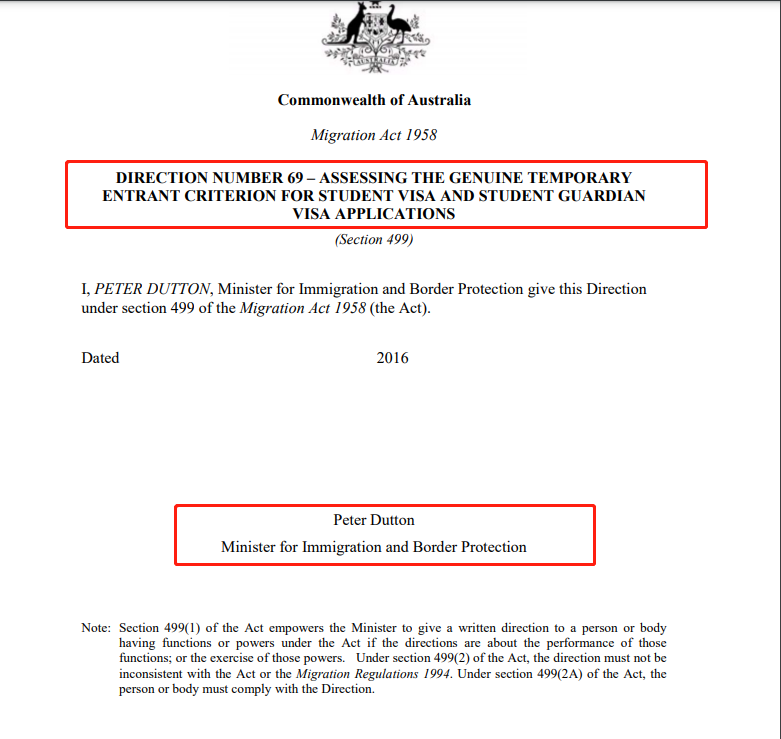
In this document, Peter Dutton, the Minister for Immigration and Border Protection, introduces how the visa officer processes the student and guardian visas.
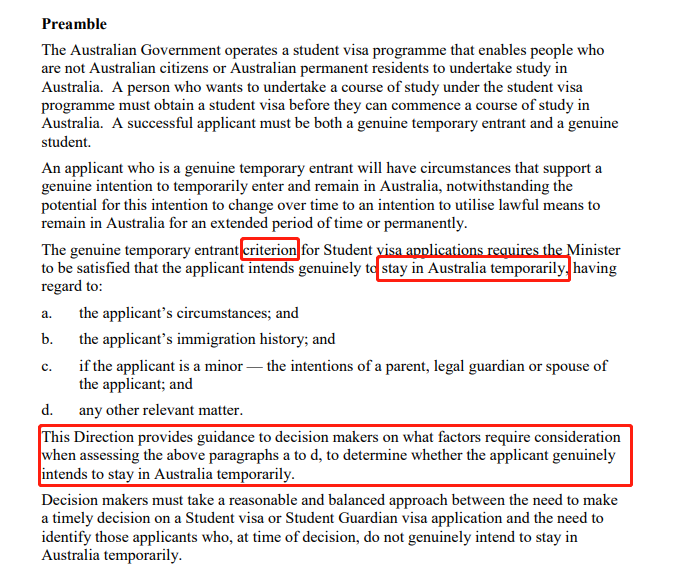
We can see from the preamble that the minister mentions the term: “stay in Australia temporarily” a few times. In other words, when reading your application, they do not want to read about your intention to stay in Australia, even if you may be able to successfully immigrate in the future.
The visa officer will decide whether to grant your visa or not, depending on your situation, immigration history, and the other factors if you are the guardian of a dependent.
In this Direction, Dutton explains some points that the visa officer looks at to assess and evaluate a student visa application. See below:
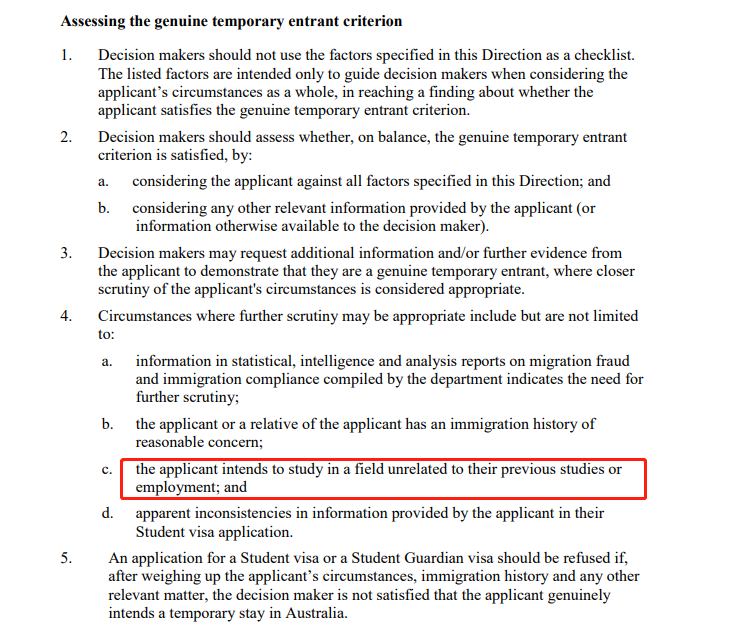
The visa officer won’t use the factors specified in this Direction as a checklist for visa application assessment; rather, the listed factors are intended as a guide for when they are processing the application.
The visa officer may request additional information and evidence from the applicant to prove that they do not intend to immigrate to Australia in the future. Dutton puts a particular emphasis on the applicant who intends to study in a field unrelated to their previous studies or employment, from whom the visa officer has the right to request further evidence to verify their purpose for coming to Australia.
These students need to carefully explain why they chose a field unrelated to their study and employment background. We’ll go into more detail later in this post about how you can avoid writing an unconvincing explanation in your GTE statement.
Essentially, when assessing a GTE statement, the Visa Officer should evaluate:
- The applicant’s circumstances in their home country
- The applicant’s potential circumstances in Australia
- The value of the course to the applicant’s future
- The possibility of the applicant’s intention for maintaining a residence in Australia
- The applicant’s immigration history
- If the applicant is a minor – the intention’s of a parent, legal guardian or spouse of the applicant
- Any other relevant matter
We’ll go through each of these now and the factors the visa officer should take into account for each point.
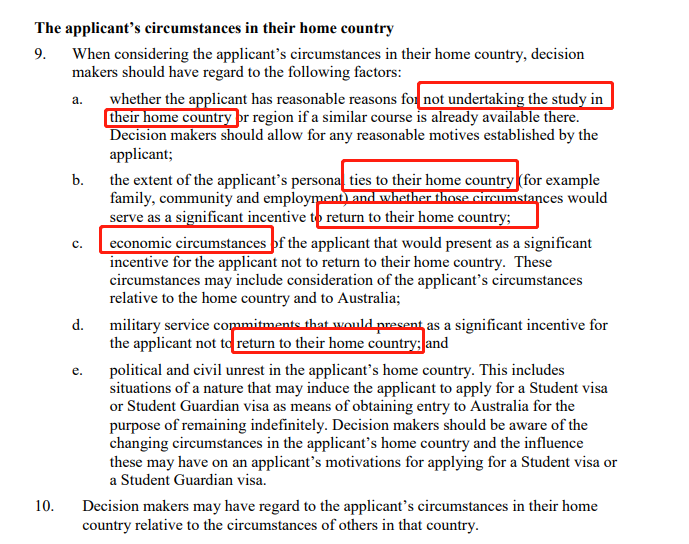
Home country:
- Reasons why the applicant does not undertake the study in their home country
- The applicant’s personal ties to their home country (incentive to return to their home country after the completion of their studies)
- The applicant’s financial circumstances (incentive to work in Australia after the completion of their studies)
- The applicant’s military service commitment as an incentive not to return to their home country
- The incentive to illegally stay in Australia due to political and civil unrest in the applicant’s home country

Potential circumstances in Australia:
- The applicant’s tie with Australia (incentive to remain in Australia after the completion of their studies) which includes family and community ties
- Whether the student visa is being used to hide the intention to immigrate to Australia
- Whether the student visa is being used to maintain residency in Australia
- Whether a relationship between the primary applicant and the sub-applicant was made for a successful student visa outcome
- The applicant’s knowledge of living in Australia, their intended course of study and education provider, their previous qualification, and the level of research the applicant has undertaken into their course of study and living arrangement
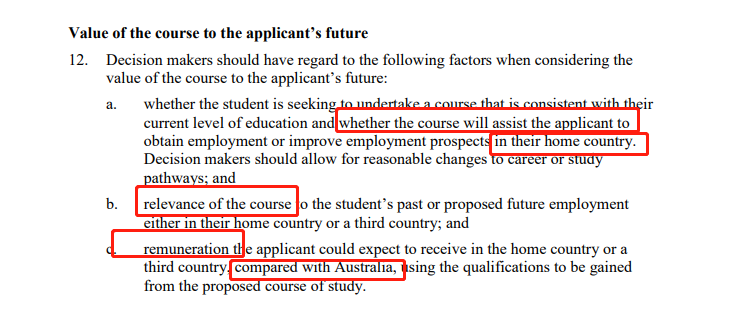
Future:
- Whether the student’s undertaken course would help the applicant to obtain an employment or employment promotion in their home country (do not present the employment potential in Australia in your GTE, as this would be regarded as having immigration intention
- The relevance of the course to the student’s past or future employment in their home country or other countries beyond Australia
- Salary the applicant would expect to receive in the home country or a third country after the completion of the course (compare with the salary in Australia). Also, compare the salary expected in the home country if the applicant received a qualification within their home country
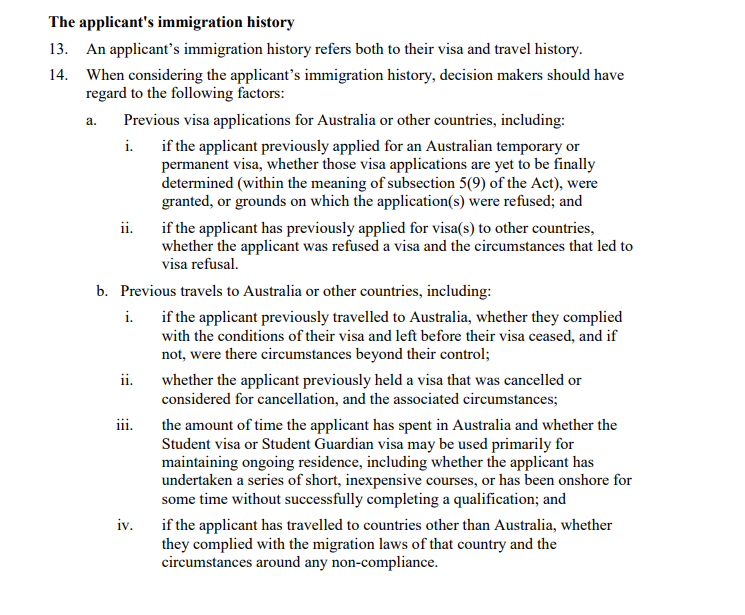
Immigration history:
The visa officer should also verify the applicant’s visa and travel history (including countries other than Australia) to check whether they previously held a visa that was cancelled or they did not comply with another country’s migration laws.
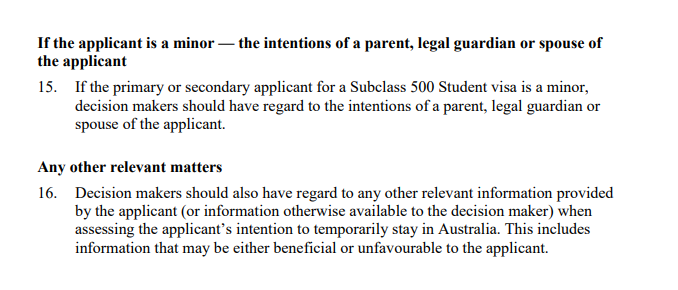
Under 18 years:
If the student visa applicant is under 18 years old, the visa officer should assess the parents, legal guardian, or sponsor’s intentions.
It’s important to reiterate that the factors that a visa officer will look at when assessing the applicant’s GTE statement may include but aren’t limited to the above factors, so keep this in mind for your own GTE statement.
Overview of a credible GTE statement:
Overall, a credible GTE statement should include the following contents:
- A personal introduction including your family, financial condition, education and employment background.
Your statement should prove that you have enough funds to support yourself financially without the need to work part-time during the study period. You need to make sure you avoid statements that reflect an intention to immigrate in the future. Contact your immigration agent for further information and advice.
- Reasons to study in Australia rather than in your home country.
You can praise the education system in Australia, which is accredited globally. You could mention that studying in Australia would broaden your horizons and improve your English competency. Compare Australia to other countries of a similar calibre like the United States or UK, including cost comparisons and the duration of your desired qualification. Be mindful not to overpraise Australia, which might, on the contrary, reflect an intention to immigrate and lead to a visa rejection.
- Reasons for choosing your education provider.
You need to specify the differences between your chosen education provider and other education providers. Let’s use AIBT as an example. You could say that AIBT is a private college with the best facilities in Australia that provides over 90 vocational courses. It’s equipped with simulated labs, engineering workshops, and training restaurants in all three of its locations (Brisbane, Sydney, and Hobart). Statements like these would show the visa officer that you have researched your ideal school.
Always assess other education providers in your GTE statement to prove that you’re knowledgeable about your chosen education provider and explain why it’s a better option than other providers. Think of it this way – if an individual knows nothing about where to study, how would the visa officer be convinced that they’re coming to Australia for education purposes?
- Reasons for choosing to undertake the course of study specified in your visa application.
You can relate your undertaken course to your previous education or employment background, e.g. you’re interested in that particular study area and want to upskill in that industry. If you have expressed interest in the area of study for some time, make sure to write this in your GTE statement as it adds value as to why this course of study is important to you. For more information, please contact your education agent.
- Value of the course to your future development.
You must state your intention to return to your home country straight after completing your studies in Australia. Do not say you plan to work in Australia to accumulate work experience, as this may sound like you intend to immigrate to Australia. What jobs are available to you once you return home? What new developments in your country would need the skills and qualifications you will have once you have completed your qualification? How would living in an English speaking country help you get a job in your home country?
Your GTE statement should contain all the points above, which will be evaluated by the visa officer to assess your purpose for coming to Australia.
AIBT has recruited over 9,000 international students from over 80 different countries around the world. From our experience, we recommend the following two groups of students pay particular attention when writing their GTE statement.
Category 1: Gap Year Students
“Gap Year Students” refers to students who take a break from formal education to travel or work after completion of their previous studies. In this case, it means the applicant experienced a period of not being a student before applying for the student visa in Australia.
For example, Student A has planned to study cookery in Australia after graduating from high school. During the time he spent preparing for the IELTS test, he found a job as a cook at a local hotel to gain some work experience at the same time. One year later, he applied for SIT30816 – Certificate III in Commercial Cookery in AIBT. Student A, as an applicant who had a gap year, should explain in his GTE Statement why he decided to study after being employed.
You need to be aware that an unconvincing statement would give the visa officer an impression that you might be inclined to reside in Australia, thereby putting your visa application at risk of being refused. Avoid this by clearly explaining why you took time off in between your studies.
Here’s a summary of factors that gap students should keep in mind:
- If your undertaken course is related to your employment background: You only need to state your aspiration for further development in this industry, where the undertaken course will assist you in reaching the goal. Show proof of your employment background when possible.
- If your undertaken course is NOT related to your employment background: You should explain why you have chosen the undertaken course rather than a course related to your previous employment. For example, you could say that your experiences working during your gap year helped you find your preferred field of studies.
- Your undertaken course is related to your educational background: Students in this situation will not be affected by their working experience unrelated to the undertaken course as long as proving their intention for further education in the same field of study. The employment during the gap year can be explained as a way to experience the workplace to be job-ready.
- Your undertaken course is NOT related to your educational background: You must be careful when writing your GTE statement and clarify the reasons why you applied for a new field of study rather than your previous study areas. It’s not uncommon for students to apply for courses that can lead to immigration outcomes, such as the chef, mechanic, and childcare centre manager. Under this situation, we suggest you prove that you want to learn extra professional skills which could boost your employment potential in your home country.
These students are at a higher risk of visa rejection compared to fresh graduates. Therefore, we suggest you contact your education and immigration agent who has professional experience.
Category 2: Working Holiday Visa Holders
The Working Holiday Visa (subclass 417) (WHV) allows visa holders to work, study, and travel in Australia. The WHV aims to provide young adults who want to spend holidays in Australia and work here to fund their holiday. Many visa holders fall in love with Australia and hope to reside in this country when they are travelling around. There are a few other pathways to stay in Australia, but depending on your situation, these might not be the best choice.
Innovation and investment immigration requires lots of money; studying in universities is costly and requires a high IELTS mark; a partner visa may sacrifice your life happiness if you meet the wrong person.
A great option is to study a course that is related to an occupation on the skilled occupation list at a vocational education provider.
As one of the best private vocational education colleges in Australia, AIBT offers a variety of courses at affordable prices (we offer two-year courses for only $14,000-$16,000 – that’s less than the tuition fee for just one semester at university!) to help you fulfil your immigration dream.
If you’d like more information on which courses have the potential to lead to an immigration outcome, scan the QR code at the end of this post to contact our course consultant.
OK, let’s go back to our topic.
WHV holders can submit their student visa application in Australia and overseas, but are there any factors those applicants need to be aware of? How can you adequately express your aspirations to study instead of immigrating? Here are a few things you need to know before applying for your student visa:
- Choose a nationally recognised and reputed vocational education provider rather than one that offers the cheapest tuition fees.
There are many vocational education providers in Australia that have not been recognised by the Australian Government. You should always check whether your desired school is registered with the Australian Government’s CRICOS system, as unregistered education providers are not qualified to educate.
To know what is CRICOS registered and how to check your courses and schools, check out our blog post about the 485 visa.
Choosing a reputable vocational education provider shows your aspiration to study and reduces the doubt from your visa officer that you have a hidden intention to reside in Australia. It’s a good idea to choose AIBT, which is regarded as one of the best private vocational education providers in Australia with over 90 verified courses.
- Choose the course of study that is related to your employment during the working holiday period.
The visa officer will evaluate the relevance between your undertaken course and your employment background when processing your student visa application. If your undertaken course is unrelated to your employment, you must give persuasive explanations to convince the visa officer; an unclear statement may cause a visa refusal due to the lack of evidence to prove your genuine temporary entrance.
- Reasons for choosing to study in Australia rather than in your home country.
You can indicate that you have gained a new understanding of the course undertaken and the advantage of the Australian education system that is globally recognised. You can learn English at the same time. Remember not to overpraise Australia as a great place to live and work – which could be seen as an intention for immigration.
Wrapping it up
The GTE statement is an imperative visa application document. Careless and inadequate preparation for your GTE statement may jeopardise your visa application and risk your visa being rejected. The GTE statement is the fastest way for a visa officer to know an applicant’s background, the purpose of stay, and career plan, so it’s important to word your GTE carefully and accurately.
If you are going to apply for your student visa or extension, we highly suggest you take the time to compose your GTE statement carefully. Pay attention to the structure, logic, and content. We recommend those without GTE writing experience to contact your education and immigration agent, where you can find more information.
Choose AIBT to fulfil your career dream!
Visit our website to learn more about our courses, or view our latest promotions: https://aibtglobal.edu.au/courses/
Contact our Commercial Sales Team: http://bit.ly/aibtcommercialteam
Scan the QR code below to talk to our course consultant on WeChat:
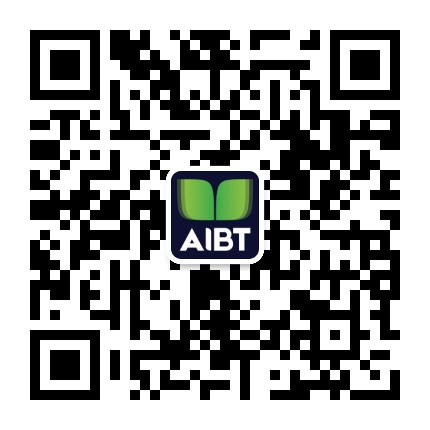
*The information within this post is correct at the time of publication. For the most up to date information please refer to the Australian Government’s Home Affairs website. AIBT does not commit to securing migration or education assessment outcomes for overseas students. We strongly advise that you consult with a registered migration agent if you require more specific information.
Brighton Pacific Pty Ltd T/A Australia Institute of Business and Technology RTO: 41138 | CRICOS: 03430J






